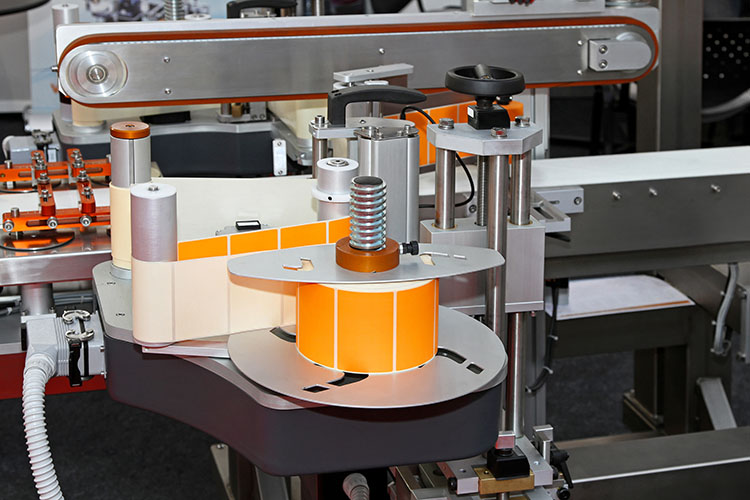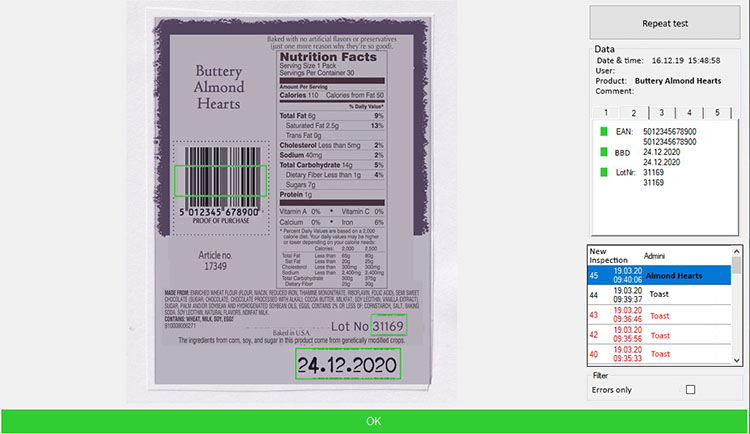
Mixing up label rolls in production is every food manufacturer’s nightmare. Visual inspection of the products is time- consuming, personnel-intensive, and still carries the risk of swapped digits or oversights, despite the four-eyes principle.
It can happen so quickly: the wrong label on a product. Or maybe the label declares the correct product but sadly in the wrong language. Due to global trading, the same label is usually available in several languages. But not every worker is multilingual and able to immediately differentiate between multiple languages without erring. It is just a question of time until someone makes a mistake while loading the packaging machine. More often than not, these errors are only detected after numerous batches have been produced – an expensive mistake! Inline control of every single product is a possible solution. This is particularly challenging due to the large variety of packaging found in the food industry. If the inline system must adapt to stretch films, cardboard boxes, tubular bags, tins, paper composites, vacuum packaging or jars, complexity and expenses soar. In addition, the labels of piece goods are often curved and therefore not machine-readable.
Image processing systems that are currently available to solve these problems are often simply too expensive for most applications. Therefore, most companies try to find a solution using low-cost intelligent sensors, but these are not able to scan several areas of print simultaneously. Furthermore, they fail when a slightly poorer print quality should still be accepted as readable – the number of false positives is therefore much too high. Nor do these scanners offer the possibility to network with the factory’s computer system or to scan the relevant set values for comparison.
But digital image processing in combination with artificial intelligence offers an innovative solution. These technologies are becoming increasingly relevant in almost all branches of industry. Solutions based on the evaluation of images are booming, not least due to the challenges of the Fourth Industrial Revolution: digitalization and the rise of smart technologies of production. The trend to use digital technology to carry out or support process monitoring, quality controls, packaging processes, completeness checks, etc., halts before no industry. In the food industry, products are measured and quality is monitored on the basis of optical criteria or the imprints of best-before dates are checked. Checking labels for correctness is also possible with this technology.

Defining Labels
Using this procedure, the products are not inspected inline. Instead, the label roll is checked before it is loaded to ensure it is the correct one. In a previous step, the software had been taught any desired number of products. For this process, all the labels of each product are scanned. After scanning these sample sheets, the individual labels are defined in a clearly structured mask, followed by the respective data – usually an EAN code, the label number, the best-before date, the LOT number and a QR code.

Defining Label Data
Before starting the production process, all required labels or foils of the product are placed on a reference sheet, which is then scanned and compared to the data in the database. If the system determines that all data are correct, production can commence.

All data are correct, production can start
Should the label differ from the stored sample, an error is reported, which can then be corrected before production begins.
The hardware in use is a standard desktop scanner requiring little space. The highly developed and powerful software based on artificial intelligence can record and process complex data. During the inspection process, all types of labels, including the outer packaging labels, are recognized and all identification numbers, codes, batch numbers and best before dates are compared with the stored data record – both static data, such as a label number, and variable data, such as an expiry date or batch number, are compared in this process. At the same time, a documentation protocol is created. If the software registers an error, production is not released, and the responsible employee is informed. This prevents an incorrect label or film roll that has been inadvertently taken from stock from being processed in production. The error can therefore be rectified before any damage is done.

Scanning the label inspection sheet
The image processing company Strelen Control Systems, based near Frankfurt, Germany, has developed a solution for this task. Safe-Ident Label is a tried and tested system that is already being used successfully by a large German meat product manufacturer and a frozen food producer. A neural network is used for character recognition and Safe-Ident Label is supplied with a comprehensive database of learned fonts that can be identified and read directly upon installation.
This elegant and efficient solution can be combined with other Strelen products in order to perform several inspection tasks with only one system. For example, inline code readers are often at a loss if the identity code of a package is not always in the same spot. With Strelen’s Safe-Ident Code, every code on a product is detected and read regardless of its position. Even more advanced is Safe-Ident OCR which can furthermore check all variable data inline, even at very high production speeds or under difficult environmental conditions.
Author — Jochen Naumann is project manager and senior software developer in the area of image processing systems at Strelen Control Systems GmbH.


